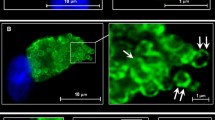Abstract
The presence of moderate amounts of histamine in the human placenta was confirmed (0.72±0.10 μg/g wet weight), and the hitherto unknown storage site of this biogenic amine was elucidated. Mast cells were identified by their characteristic morphology, staining reactions and secretory activity measured in terms of histamine release.
Human placental tissue contains 7.6×105 mast cells/g wet weight, identified by staining with toluidine blue or alcian blue, and these cells were positive for chloro-acetate-esterase. Light microscope studies of placental tissue stained with HRP-conjugated anti-human IgE demonstrated cells with a typical ‘halo’ effect indicating cell-bound IgE, and electron microscopy revealed cells containing membrane-bound electron dense granules. A single mast cell was calculated to contain approximately 1 pg of histamine. Enzymatic digestion of placental tissue with collagenase (1.5 mg/ml) yielded viable cell suspensions, containing mast cells in a purity of 0.6% which exhibited a low spontaneous output of histamine (12%). Placental mast cells released histamine in a concentration dependent manner upon challenge with anti-human IgE and the calcium ionophore A23187. Also, unlike other human mast cells so far studied, with the exception of skin, those dispersed from human placenta were responsive to the polybasic secretagogue compound 48/80.
These findings represent a novel source of human mast cells and, since placentas are readily available in quantity, such tissue is proposed as an ideal source of mast cells for biochemical and pharmacological use.
Similar content being viewed by others
References
F. Wicksell,Observations on histamine and histaminolysis in pregnancy. Acta. Physiol. Scand.17, 395–414 (1949).
R.E. Gunther and D. Glick,Determination of histaminase activity in histologic samples and its quantitative distribution in intact human placenta and uterus. J. Histochem. Cytochem.15, 431–435 (1967).
H. Selye,The Mast Cells. pp. 116–117, Butterworth and Company, London 1965.
U.S. Euler,Action of adrenaline, acetylcholine and other substances on nerve-free vessels (human placenta). J. Physiol.93, 129–143 (1938).
F.W. Kohler, R.F. Gautieri and D.E. Mann,Detection of histamine in human placental perfusate and the effect of histamine releasers. Res. Commun. Chem. Pathol. Pharmacol.61, 185–200 (1988).
A.H. Anton and D.F. Sayre,A modified fluorimetric procedure for tissue histamine and its distribution in various animals. J. Pharmacol. Exp. Ther.166, 285–292 (1969).
F.J. van Overveld,Some aspects of mast cell subtypes from human lung tissue. A comparison between normal individuals and patients with chronic obstructive lung disease. pp. 57–72, Fisons B. V., Leusden, The Netherlands 1988.
M.A. Lowman, P.H. Rees, R.C. Benyon and M.K. Church,Human mast cell heterogeneity: histamine release from mast cells dispersed from human skin, lung, adenoids, tonsils and colon in response to IgE-dependent and non-immunologic stimuli. J. Allergy Clin. Immunol.81, 590–597 (1988).
A. Goth and H.R. Adams,Selective effect of phosphatidylserine on macromolecular histamine release in the rat. Fed. Proc.29, 2087 (1970).
W.M. Purcell and T.H.P. Hanahoe,Human placenta: a novel source of mast cells. Br. J. Pharmacol.100, 334P (1990).
Author information
Authors and Affiliations
Rights and permissions
About this article
Cite this article
Purcell, W.M., Hanahoe, T.H.P. A novel source of mast cells: The human placenta. Agents and Actions 33, 8–12 (1991). https://doi.org/10.1007/BF01993113
Issue Date:
DOI: https://doi.org/10.1007/BF01993113




